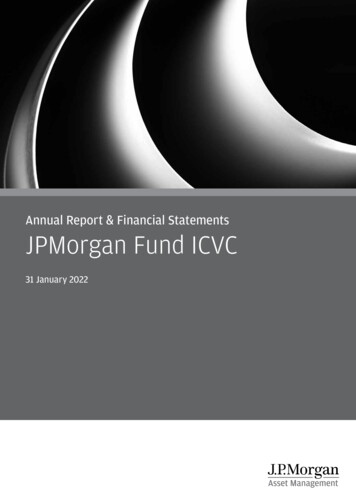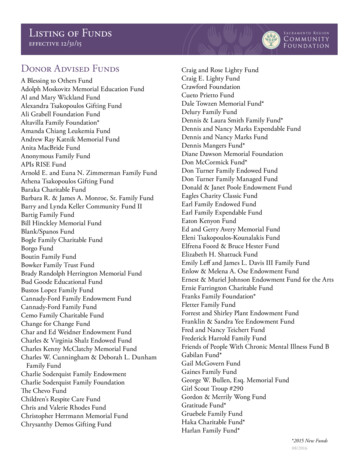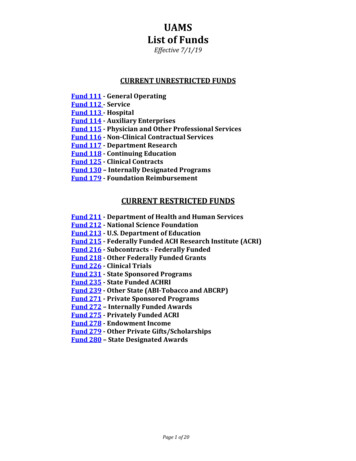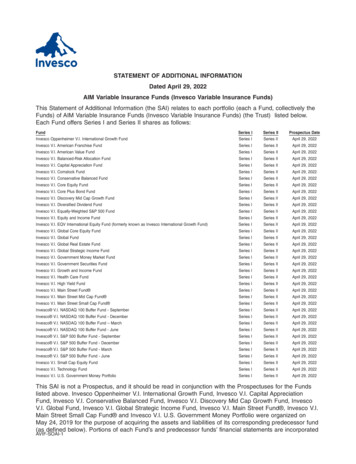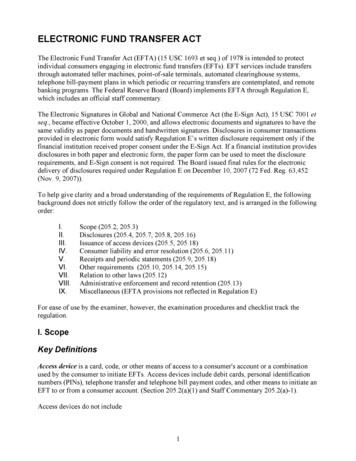
Transcription
ELECTRONIC FUND TRANSFER ACTThe Electronic Fund Transfer Act (EFTA) (15 USC 1693 et seq.) of 1978 is intended to protectindividual consumers engaging in electronic fund transfers (EFTs). EFT services include transfersthrough automated teller machines, point-of-sale terminals, automated clearinghouse systems,telephone bill-payment plans in which periodic or recurring transfers are contemplated, and remotebanking programs. The Federal Reserve Board (Board) implements EFTA through Regulation E,which includes an official staff commentary.The Electronic Signatures in Global and National Commerce Act (the E-Sign Act), 15 USC 7001 etseq., became effective October 1, 2000, and allows electronic documents and signatures to have thesame validity as paper documents and handwritten signatures. Disclosures in consumer transactionsprovided in electronic form would satisfy Regulation E’s written disclosure requirement only if thefinancial institution received proper consent under the E-Sign Act. If a financial institution providesdisclosures in both paper and electronic form, the paper form can be used to meet the disclosurerequirements, and E-Sign consent is not required. The Board issued final rules for the electronicdelivery of disclosures required under Regulation E on December 10, 2007 (72 Fed. Reg. 63,452(Nov. 9, 2007)).To help give clarity and a broad understanding of the requirements of Regulation E, the followingbackground does not strictly follow the order of the regulatory text, and is arranged in the followingorder:I.II.III.IV.V.VI.VII.VIII.IX.Scope (205.2, 205.3)Disclosures (205.4, 205.7, 205.8, 205.16)Issuance of access devices (205.5, 205.18)Consumer liability and error resolution (205.6, 205.11)Receipts and periodic statements (205.9, 205.18)Other requirements (205.10, 205.14, 205.15)Relation to other laws (205.12)Administrative enforcement and record retention (205.13)Miscellaneous (EFTA provisions not reflected in Regulation E)For ease of use by the examiner, however, the examination procedures and checklist track theregulation.I. ScopeKey DefinitionsAccess device is a card, code, or other means of access to a consumer's account or a combinationused by the consumer to initiate EFTs. Access devices include debit cards, personal identificationnumbers (PINs), telephone transfer and telephone bill payment codes, and other means to initiate anEFT to or from a consumer account. (Section 205.2(a)(1) and Staff Commentary 205.2(a)-1).Access devices do not include1
Magnetic tape or other devices used internally by a financial institution to initiateelectronic transfers, A check or draft used to capture the MICR (Magnetic Ink Character Recognition)encoding or routing, account, and serial numbers to initiate a one-time ACH debit. (StaffCommentary 205.2(a)-1 and -2).Accepted access device is a device that a consumer: Requests and receives, or signs, or uses (or authorizes another to use) the access device totransfer money between accounts or to obtain money, property, or services; Requests validation of the access device even if it was issued on an unsolicited basis; or Receives an access device as a renewal or substitute for an accepted access device from eitherthe financial institution that initially issued the device or a successor. (Section 205.2(a)(2)).Account includes a: Checking, savings, or other consumer asset account held by a financial institution(directly or indirectly), including certain club accounts, established primarily forpersonal, family, or household purposes.; or “Payroll card account,” established through an employer (directly or indirectly), towhich EFTs of the consumer’s wages, salary, or other employee compensation (such ascommissions), are made on a recurring basis. The payroll card account can be operatedor managed by the employer, a third-party processor, a depository institution, or anyother person. All transactions involving the transfer of funds to or from a payroll cardaccount are covered by the regulation. (Section 205.2(b)(1) and Staff Commentary205.2(b)-1).An account does not include an account held by a financial institution under a bona fide trustagreement; an occasional or incidental credit balance in a credit plan; profit-sharing and pensionaccounts established under a bona fide trust agreement; escrow accounts such as for payments ofreal estate taxes, insurance premiums, or completion of repairs; or accounts for purchasing U.S.savings bonds. (Section 205.2(b)(3) and Staff Commentary 205.2(b)-3).A “payroll card account” does not include a card used: Solely to disburse incentive-based payments (other than commissions when canrepresent the primary means through which a consumer is paid) that are unlikely to be aconsumer’s primary source of salary or other compensation. Solely to make disbursements unrelated to compensation, such as petty cashreimbursements or travel per diem payments. In isolated instances to which an employer typically does not make recurring payments.(Staff Commentary 205.2(b)-2).2
ATM operator is any person that operates an ATM at which a consumer initiates an EFT or abalance inquiry and that does not hold the account to or from which the transfer is made or aboutwhich the inquiry is made. (Section 205.16(a)).Electronic funds transfer (EFT) is a transfer of funds is initiated through an electronic terminal,telephone, computer (including on-line banking) or magnetic tape for the purpose of ordering,instructing, or authorizing a financial institution to debit or credit a consumer’s account. EFTsinclude, but are not limited to point-of-sale (POS) transfers; automated teller machine (ATM)transfers; direct deposits or withdrawals of funds; transfers initiated by telephone; and transfersresulting from debit card transactions, whether or not initiated through an electronic terminal.(Section 205.3(b)).Electronic terminal is an electronic device, other than a telephone call by a consumer, throughwhich a consumer may initiate an EFT. The term includes, but is not limited to, point-of-saleterminals, automated teller machines, and cash-dispensing machines. (Section 205.2(h)).Preauthorized electronic fund transfer is an EFT authorized in advance to recur at substantiallyregular intervals. (Section 205.2(k)).Unauthorized electronic fund transfer is an EFT from a consumer's account initiated by a personother than the consumer without authority to initiate the transfer and from which the consumerreceives no benefit. This does not include an EFT initiated: By a person who was furnished the access device to the consumer's account by the consumer,unless the consumer has notified the financial institution that transfers by that person are nolonger authorized; With fraudulent intent by the consumer or any person acting in concert with the consumer; or By the financial institution or its employee. (Section 205.2(m)).Coverage - Section 205.3The requirements of Regulation E apply only to accounts for which there is an agreement for EFTservices to or from the account between (i) the consumer and the financial institution or (ii) theconsumer and a third party, when the account-holding financial institution has received notice of theagreement and the fund transfers have begun. (Staff Commentary 205.3(a)-1).Regulation E applies to all persons, including offices of foreign financial institutions in the UnitedStates, that offer EFT services to residents of any state and it covers any account located in theUnited States through which EFTs are offered to a resident of a state, no matter where a particulartransfer occurs or where the financial institution is chartered. (Staff Commentary 205.3(a)-3).Regulation E does not apply to a foreign branch of a U.S. financial institution unless the EFTservices are offered in connection with an account in a state, as defined in section 205.2(l). (StaffCommentary 205.3(a)-3).Exclusions from Coverage - Section 205.3(c) describes transfers that are not EFTs and aretherefore not covered by the EFTA and Regulation E:3
Transfers of funds originated by check, draft, or similar paper instrument. Check guarantee or authorization services that do not directly result in a debit or credit to aconsumer’s account. Any transfer of funds for a consumer within a system that is used primarily to transfer fundsbetween financial institutions or businesses, e.g., Fedwire or other similar network. Any transfer of funds which has as its primary purpose the purchase or sale of securities orcommodities regulated by the Securities and Exchange Commission (SEC) or the CommodityFutures Trading Commission (CFTC), purchased or sold through a broker-dealer regulated bythe SEC or through a futures commission merchant regulated by the CFTC, or held in bookentry form by a Federal Reserve Bank or federal agency. Intra-institutional automatic transfers under an agreement between a consumer and a financialinstitution. Transfers initiated by telephone between a consumer and a financial institution provided thetransfer is not a function of a written plan contemplating periodic or recurring transfers. Awritten statement available to the public, such as a brochure, that describes a service allowing aconsumer to initiate transfers by telephone constitutes a written plan. Preauthorized transfers to or from accounts at financial institutions with assets of less than 100 million on the preceding December 31. Such preauthorized transfers, however, remainsubject to the compulsory use prohibition under section 913 of the EFTA and 12 CFR205.10(e), as well as the civil and criminal liability provisions of sections 915 and 916 of theEFTA. A small financial institution that provides EFT services besides preauthorized transfersmust comply with the Regulation E requirements for those other services. (Staff Commentary205.3(c)(7)-1). For example, a small financial institution that offers ATM services mustcomply with Regulation E in regard to the issuance of debit cards, terminal receipts, periodicstatements, and other requirements.Electronic Check Conversion (ECK) and Collection of Returned-Item FeesRegulation E covers electronic check conversion (ECK) transactions. In an ECK transaction, aconsumer provides a check to a payee and information from the check is used to initiate a one-timeEFT from the consumer’s account. Although transfers originated by checks are not covered byRegulation E, an ECK is treated as an EFT and not a payment originated by check. Payees mustobtain the consumer’s authorization for each ECK transaction. A consumer authorizes a one-timeEFT for an ECK transaction when the consumer receives notice that the transaction will or may beprocessed as an EFT and goes forward with the underlying transaction.1 (Sections 205.3(b)(2)(i) and(ii) and Staff Commentary 205.3(b)(2)-3).1For POS transactions, the notice must be posted in a prominent and conspicuous location and a copy of the noticemust be provided to the consumer at the time of the transaction. (Sections 205.3(b)(2)(i) and (ii) and Staff Commentary205.3(b)(2)-3).4
Until December 31, 2009, a person using the check to initiate the EFT must include a notice thatfunds may be withdrawn from the consumer’s account as soon as the same day payment is received,and, as applicable, that the consumer’s check will not be returned by the financial institution.(Section 205.3(b)(2)(iii) and Appendix A-6).If a payee re-presents electronically a check that has been returned unpaid, the transaction is not anEFT, and Regulation E does not apply because the transaction originated by check. (StaffCommentary 205.3(c)(1)-1).However, Regulation E applies to a fee collected electronically from a consumer’s account for acheck or EFT returned unpaid. A consumer authorizes a one-time EFT from the consumer’s accountto pay the fee for the returned item or transfer if the person collecting the fee provides notice to theconsumer stating the amount of the fee and that the person may electronically collect the fee, andthe consumer goes forward with the underlying transaction.2 (Section 205.3(b)(3)). Theseauthorization requirements do not apply to fees imposed by the account-holding financial institutionfor returning the check or EFT or paying the amount of an overdraft. (Staff Commentary205.3(b)(3)-1).II. DisclosuresDisclosures Generally —Section 205.4Required disclosures must be clear and readily understandable, in writing, and in a form theconsumer may keep. The required disclosures may be provided to the consumer in electronic form,if the consumer affirmatively consents after receiving a notice that complies with the E-Sign Act.(Section 205.4(a)(1)).Disclosures may be made in a language other than English, if the disclosures are made available inEnglish upon the consumer’s request. (Section 205.4(a)(2)).A financial institution has the option of disclosing additional information and combining disclosuresrequired by other laws (for example, Truth in Lending disclosures) with Regulation E disclosures.(Section 205.4(b)).A financial institution may combine required disclosures into a single statement if a consumer holdstwo or more accounts at the financial institution. Thus, a single periodic statement or errorresolution notice is sufficient for multiple accounts. In addition, it is only necessary for a financialinstitution to provide one set of disclosures for a joint account. (Section 205.4(c)(l) and (2)).Two or more financial institutions that jointly provide EFT services may contract among themselvesto meet the requirements that the regulation imposes on any or all of them. When making initialdisclosures (see Section 205.7) and disclosures of a change in terms or an error resolution notice(see Section 205.8), a financial institution in a shared system only needs to make disclosures that2For POS transactions, the notice must be posted in a prominent and conspicuous location and a copy of the notice musteither be provided to the consumer at the time of the transaction or mailed to the consumer’s address as soon asreasonably practicable after the person initiates the EFT to collect the fee. (Section 205.3(b)(3)).5
are within its knowledge and apply to its relationship with the consumer for whom it holds anaccount. (Section 205.4(d)).Initial Disclosure of Terms and Conditions—Section 205.7Financial institutions must provide initial disclosures of the terms and conditions of EFT servicesbefore the first EFT is made or at the time the consumer contracts for an EFT service. They mustgive a summary of various consumer rights under the regulation, including the consumer's liabilityfor unauthorized EFTs, the types of EFTs the consumer may make, limits on the frequency or dollaramount, fees charged by the financial institution, and the error-resolution procedures. Appendix Ato Part 205 provides model clauses that financial institutions may use to provide the disclosures.Timing of Disclosures. Financial institutions must make the required disclosures at the time aconsumer contracts for an electronic fund transfer service or before the first electronic fund transferis made involving the consumer's account. (Section 205.7(a)).Disclosures given by a financial institution earlier than the regulation requires (for example, whenthe consumer opens a checking account) need not be repeated when the consumer later authorizesan electronic check conversion or agrees with a third party to initiate preauthorized transfers to orfrom the consumer's account, unless the terms and conditions differ from the previously disclosedterm. This interpretation also applies to any notice provided about one-time EFTs from a consumer'saccount initiated using information from the consumer's check. On the other hand, if an agreementfor EFT services to be provided by an account-holding financial institution is directly between theconsumer and the account-holding financial institution, disclosures must be given in close proximityto the event requiring disclosure, for example, when the consumer contracts for a new service.(Staff Commentary 205.7(a)-1).Where a consumer authorizes a third party to debit or credit the consumer's account, an accountholding financial institution that has not received advance notice of the transfer or transfers mustprovide the required disclosures as soon as reasonably possible after the first debit or credit is made,unless the financial institution has previously given the disclosures. (Staff Commentary 205.7(a)-2).If a consumer opens a new account permitting EFTs at a financial institution, and the consumer hasalready received Regulation E disclosures for another account at that financial institution, thefinancial institution need only disclose terms and conditions that differ from those previously given.(Staff Commentary 205.7(a)-3).If a financial institution joins an interchange or shared network system (which provides access toterminals operated by other financial institutions), disclosures are required for additional EFTservices not previously available to consumers if the terms and conditions differ from thosepreviously disclosed. (Staff Commentary 205.7(a)-4).A financial institution may provide disclosures covering all EFT services that it offers, even if someconsumers have not arranged to use all services. (Staff Commentary 205.7(a)-5).Addition of EFT Services. A financial institution must make disclosures for any new EFT serviceadded to a consumer's account if the terms and conditions are different from those described in the6
initial disclosures. ECK transactions may be a new type of transfer requiring new disclosures. (SeeAppendix A-2) (Staff Commentary 205.7(c)-1).Content of Disclosures. Section 205.7(b) requires a financial institution to provide the followingdisclosures as they apply: Liability of consumers for unauthorized electronic fund transfers. The financial institutionmust include a summary of the consumer’s liability (under section 205.6, state law, or otherapplicable law or agreement) for unauthorized transfers. (Section 205.7(b)(1)) A financialinstitution does not need to provide the liability disclosures if it imposes no liability. If it laterdecides to impose liability, it must first provide the disclosures. (Staff Commentary 205.7(b)(1)1). The financial institution can choose to include advice on promptly reporting unauthorizedtransfers or the loss or theft of the access device. (Staff Commentary 205.7(b)(1)-3). Telephone number and address. A financial institution must provide a specific telephonenumber and address, on or with the disclosure statement, for reporting a lost or stolen accessdevice or a possible unauthorized transfer. (Staff Commentary 205.7(b)(2)-2). Except for thetelephone number and address for reporting a lost or stolen access device or a possibleunauthorized transfer, the disclosure may insert a reference to a telephone number that is readilyavailable to the consumer, such as “Call your branch office. The number is shown on yourperiodic statement.” Business days. The financial institution's business days. (Section 205.7(b)(3)). Types of transfers; limitations on frequency or dollar amount. Limitations on the frequencyand dollar amount of transfers generally must be disclosed in detail. (Section 205.7(b)(4)). If theconfidentiality of certain details is essential to the security of an account or system, these detailsmay be withheld (but the fact that limitations exist must still be disclosed).3 A limitation onaccount activity that restricts the consumer's ability to make EFTs must be disclosed even if therestriction also applies to transfers made by non-electronic means.4 Financial institutions are notrequired to list preauthorized transfers among the types of transfers that a consumer can make.(Staff Commentary 205.7(b)(4)-3). Financial institutions must disclose the fact that one-timeEFTs initiated using information from a consumer's check are among the types of transfers thata consumer can make. (See Appendix A-2.) (Staff Commentary 205.7(b)(4)-4). Fees. A financial institution must disclose all fees for EFTs or for the right to make EFTs.(Section 205.7(b)(5)). Other fees (for example, minimum-balance fees, stop-payment fees,account overdrafts, or ATM inquiry fees) may, but need not, be disclosed under Regulation E(but see Regulation DD, 12 CFR Part 230). (Staff Commentary 205.7(b)(5)-1). A per-item feefor EFTs must be disclosed even if the same fee is imposed on non-electronic transfers. If a peritem fee is imposed only under certain conditions, such as when the transactions in the cycle3For example, if financial institution limits cash ATM withdrawals to 100 per day, the financial institution maydisclose that daily withdrawal limitations apply and need not disclose that the limitations may not always be in force(such as during periods when its ATMs are off-line). (Staff Commentary 205.7(b)(4)-1).4For example, Regulation D (12 CFR 204) restricts the number of payments to third parties that may be made from amoney market deposit account; a financial institution that does not execute fund transfers in excess of those limits mustdisclose the restriction as a limitation on the frequency of EFTs. (Staff Commentary 205.7(b)(4)-2).7
exceed a certain number, those conditions must be disclosed. Itemization of the various feesmay be on the disclosure statement or on an accompanying document referenced in thestatement. (Staff Commentary 205.7(b)(5)-2).A financial institution must disclose that networks used to complete the EFT as well as an ATMoperator, may charge a fee for an EFT or for balance inquiries. (Section 205.7(b)(11)). Documentation. A summary of the consumer's right to receipts and periodic statements, asprovided in section 205.9, and notices regarding preauthorized transfers as provided in sections205.10(a) and 205.10(d). (Section 205.7(b)(6)). Stop payment. A summary of the consumer's right to stop payment of a preauthorizedelectronic fund transfer and the procedure for placing a stop-payment order, as provided insection 205.10(c). (Section 205.7(b)(7)). Liability of institution. A summary of the financial institution's liability to the consumer undersection 910 of the EFTA for failure to make or to stop certain transfers. (Section 205.7(b)(8)). Confidentiality. The circumstances under which, in the ordinary course of business, thefinancial institution may provide information concerning the consumer’s account to thirdparties. (Section 205.7(b)(9)) A financial institution must describe the circumstances underwhich any information relating to an account to or from which EFTs are permitted will be madeavailable to third parties, not just information concerning those EFTs. Third parties includeother subsidiaries of the same holding company. (Staff Commentary 205.7(b)(9)-1). Error Resolution. The error-resolution notice must be substantially similar to Model Form A-3in Appendix A of Part 205. A financial institution may use different wording so long as thesubstance of the notice remains the same, may delete inapplicable provisions (for example, therequirement for written confirmation of an oral notification), and may substitute substantivestate law requirements affording greater consumer protection than Regulation E. (StaffCommentary 205.7(b)(10)-1). To take advantage of the longer time periods for resolving errorsunder section 205.11(c)(3) (for new accounts as defined in Regulation CC, transfers initiatedoutside the United States, or transfers resulting from POS debit card transactions), a financialinstitution must have disclosed these longer time periods. Similarly, a financial institutionrelying on the exception from provisional crediting in section 205.11(c)(2) for accounts relatingto extensions of credit by securities brokers and dealers (Regulation T, 12 CFR Part 220) mustdisclose accordingly. (Staff Commentary 205.7(b)(10)-2).Change in Terms; Error Resolution Notice —Section 205.8If a financial institution contemplates a change in terms it must mail or deliver a written orelectronic notice to the consumer at least 21 days before the effective date of any change in a termor condition required to be disclosed under section 205.7(b) if the change would result in any of thefollowing: Increased fees or charges;8
Increased liability for the consumer; Fewer types of available EFTs; or Stricter limitations on the frequency or dollar amounts of transfers.If an immediate change in terms or conditions is necessary to maintain or restore the security of anEFT system or account, the financial institution does not need to give prior notice. However, if thechange is to be permanent, the financial institution must provide notice in writing of the change tothe consumer on or with the next regularly scheduled periodic statement or within 30 days, unlessdisclosures would jeopardize the security of the system or account.For accounts to or from which EFTs can be made, the financial institution must mail, deliver, orprovide electronically to the consumer at least once each calendar year, the error resolution notice in12 CFR 205 Appendix A - Model Form A-3. Alternatively, the financial institution may include anabbreviated error resolution notice substantially similar to the notice set out in Appendix A (ModelForm A-3) with each periodic statement. (Section 205.8(b)).Disclosures at Automated Teller Machines—Section 205.16An ATM operator that charges a fee is required to post notice that a fee will be imposed anddisclose the amount of the fee. Notices must be posted both (1) in a prominent and conspicuouslocation on or at the machine; and (2) on the screen or on a paper notice before the consumer iscommitted to paying a fee. (Section 205.16(c)(1) and (2)). The fee may be imposed by the ATMoperator only if: (1) the consumer is provided the required notices; and (2) the consumer elects tocontinue the transaction. (Section 205.16(e)).The “clear and conspicuous notice” standard applies to notice posted on or at the ATM. The “clearand readily understandable standard” applies to the content of the notice. The requirement that thenotice be in a retainable format only applies to printed notices (not those on the ATM screen).(Section 205.16(c)).These fee disclosures are not required where a network owner is not charging a fee directly to theconsumer (i.e. some network owners charge an interchange fee to financial institutions whosecustomers use the network). If the network practices change such that the network charges theconsumer directly, these fee disclosure requirements would apply to the network.III. Issuance of Access Devices —Sections 205.5 and 205.18In general, a financial institution may issue an access device to a consumer only if: The consumer requested it in writing or orally;5 or It is a renewal of, or a substitute for, an accepted access device (as defined in section 205.2(a)).5For a joint account, a financial institution may issue an access device to each account holder for whom the requestingholder specifically requests an access device. (Staff Commentary 205.5(a)(1)-1).9
Only one renewal or substitute device may replace a previously issued device. A financialinstitution may provide additional devices at the time it issues the renewal or substitute accessdevice provided the institution complies with the requirements for issuing unsolicited accessdevices for the additional devices. (Staff Commentaries 205.5(a)(2)-1 and 205.5(b)-5).A financial institution may issue an unsolicited access device only if the access device is: Not validated — that is, it cannot be used to initiate an EFT; Accompanied by the explanation that it is not validated and how the consumer may dispose ofit if the consumer does not wish to validate it; Accompanied by a complete disclosure, in accordance with Section 205.7, of the consumer’srights and liabilities that will apply if the access device is validated; and Validated only upon oral or written request from the consumer and after a verification of theconsumer’s identity by some reasonable means. (Section 205.5(b)).The financial institution may use any reasonable means of verifying the consumer’s identity, butthe consumer is not liable for any unauthorized transfers if an imposter succeeds in validating theaccess device. (Staff Commentary 205.5(b)-4).Payroll Card Access Devices. Consistent with Section 205.5(a), a financial institution may issue apayroll card access device only in response to an oral or written request for the device or as arenewal or substitute for an accepted access device. A consumer is deemed to request an accessdevice for a payroll account when the consumer chooses to receive salary or other compensationthrough a payroll card account. (Staff Commentary 205.18(a)-1).EFT added to credit card. The EFTA and Regulation E apply when the capability to initiate EFTsis added to an accepted credit card (as defined under Regulation Z). The EFTA and Regulation Ealso apply to the issuance of an access device that permits credit extensions under a preexistingagreement between the consumer and a financial institution to extend credit only to cover overdrafts(or to maintain a specified minimum balance). The Truth in Lending Act and Regulation Z governthe addition of a credit feature to an accepted access device, and except as discussed above, theissuance of a credit card that is also an access device. For information on Regulation E’srelationship to other laws, including Truth in Lending, see Section 205.12.IV. Consumer Liability and Error ResolutionLiability of Consumers for Unauthorized Transfers —Section 205.6A consumer may be liable for an unauthorized EFT (defined in Section 205.2(m)), depending onwhen the consumer notifies the financial institution and whether an access device was used toconduct the transaction. Under the EFTA, there is no bright-line time limit within which consumersmust report unauthorized EFTs. (71 Fed. Reg. 1638, 1653 (Jan. 10, 2006)).10
The extent of the
written statement available to the public, such as a brochure, that describes a service allowing a consumer to initiate transfers by telephone constitutes a written plan. Preauthorized transfer less tso tha orn from accounts at financial institutions with assets of 100 million on the preceding Decembe 31r .



